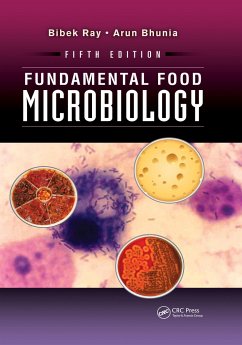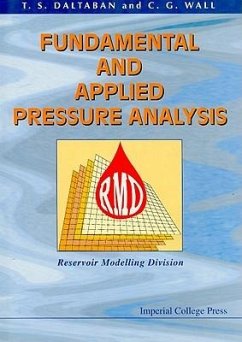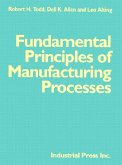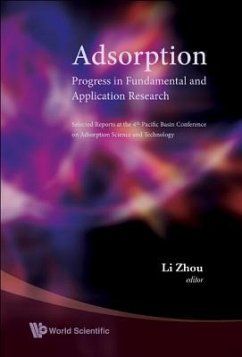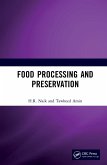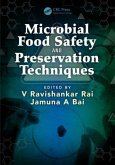- Gebundenes Buch
- Merkliste
- Auf die Merkliste
- Bewerten Bewerten
- Teilen
- Produkt teilen
- Produkterinnerung
- Produkterinnerung
Maintaining the high standard set by the previous bestselling editions, this book presents the most up-to-date information in this rapidly growing and highly dynamic field. Revised and expanded to reflect recent advances, this edition broadens coverage of foodborne diseases to include many new and emerging pathogens, as well as descriptions of the mechanism of pathogenesis. With the inclusion of many more easy-to-follow figures and illustrations, this text provides a comprehensive introductory source for undergraduates, as well as a valuable reference for graduate level and working professionals in food microbiology or food safety.…mehr
Andere Kunden interessierten sich auch für
![Fundamental and Applied Pressure Analysis Fundamental and Applied Pressure Analysis]() Tayyar Sezgin DaltabanFundamental and Applied Pressure Analysis209,99 €
Tayyar Sezgin DaltabanFundamental and Applied Pressure Analysis209,99 €![Fundamental Principles of Manufacturing Processes Fundamental Principles of Manufacturing Processes]() Robert H ToddFundamental Principles of Manufacturing Processes80,99 €
Robert H ToddFundamental Principles of Manufacturing Processes80,99 €![Physical Chemistry of Food Processes, Volume I: Fundamental Aspects Physical Chemistry of Food Processes, Volume I: Fundamental Aspects]() Ion C. BaianuPhysical Chemistry of Food Processes, Volume I: Fundamental Aspects116,99 €
Ion C. BaianuPhysical Chemistry of Food Processes, Volume I: Fundamental Aspects116,99 €![Adsorption: Progress in Fundamental and Application Research - Selected Reports at the 4th Pacific Basin Conference on Adsorption Science and Technology Adsorption: Progress in Fundamental and Application Research - Selected Reports at the 4th Pacific Basin Conference on Adsorption Science and Technology]() Adsorption: Progress in Fundamental and Application Research - Selected Reports at the 4th Pacific Basin Conference on Adsorption Science and Technology172,99 €
Adsorption: Progress in Fundamental and Application Research - Selected Reports at the 4th Pacific Basin Conference on Adsorption Science and Technology172,99 €![Food Processing and Preservation Food Processing and Preservation]() H R NaikFood Processing and Preservation154,99 €
H R NaikFood Processing and Preservation154,99 €![Principles of Food Toxicology Principles of Food Toxicology]() Tõnu PüssaPrinciples of Food Toxicology122,99 €
Tõnu PüssaPrinciples of Food Toxicology122,99 €![Microbial Food Safety and Preservation Techniques Microbial Food Safety and Preservation Techniques]() Microbial Food Safety and Preservation Techniques357,99 €
Microbial Food Safety and Preservation Techniques357,99 €-
-
-
Maintaining the high standard set by the previous bestselling editions, this book presents the most up-to-date information in this rapidly growing and highly dynamic field. Revised and expanded to reflect recent advances, this edition broadens coverage of foodborne diseases to include many new and emerging pathogens, as well as descriptions of the mechanism of pathogenesis. With the inclusion of many more easy-to-follow figures and illustrations, this text provides a comprehensive introductory source for undergraduates, as well as a valuable reference for graduate level and working professionals in food microbiology or food safety.
Hinweis: Dieser Artikel kann nur an eine deutsche Lieferadresse ausgeliefert werden.
Hinweis: Dieser Artikel kann nur an eine deutsche Lieferadresse ausgeliefert werden.
Produktdetails
- Produktdetails
- Verlag: CRC Press
- 5th edition
- Seitenzahl: 664
- Erscheinungstermin: 26. November 2013
- Englisch
- Abmessung: 261mm x 182mm x 43mm
- Gewicht: 1495g
- ISBN-13: 9781466564435
- ISBN-10: 1466564431
- Artikelnr.: 38029270
- Herstellerkennzeichnung
- Libri GmbH
- Europaallee 1
- 36244 Bad Hersfeld
- gpsr@libri.de
- Verlag: CRC Press
- 5th edition
- Seitenzahl: 664
- Erscheinungstermin: 26. November 2013
- Englisch
- Abmessung: 261mm x 182mm x 43mm
- Gewicht: 1495g
- ISBN-13: 9781466564435
- ISBN-10: 1466564431
- Artikelnr.: 38029270
- Herstellerkennzeichnung
- Libri GmbH
- Europaallee 1
- 36244 Bad Hersfeld
- gpsr@libri.de
Bibek Ray, Arun Bhunia
SECTION I: INTRODUCTION TO MICROBES IN FOODS. History and Development of
Food Microbiology. Characteristics of Predominant Microorganisms in Food.
Sources of Microorganisms in Foods. Normal Microbiological Quality of Foods
and Its Significance. SECTION II: MICROBIAL GROWTH RESPONSE IN THE FOOD
ENVIRONMENT. Microbial Growth Characteristics. Factors Influencing
Microbial Growth in Food. Microbial Attachments and Biofilm Formation.
Microbial Metabolism of Food Components. Microbial Sporulation and
Germination. Microbial Stress Response in the Food Environment. SECTION
III: BENEFICIAL US ES OF MICROORGANISMS IN FOOD. Microorganisms Used in
Food Fermentation. Biochemistry of Some Beneficial Traits. Genetics of Some
Beneficial Traits. Starter Cultures and Bacteriophages. Microbiology of
Fermented Food Production. Intestinal Bacteria and Probiotics. Food
Biopreservatives of Microbial Origin, Bacteriocin, and Nanotechnology. Food
Ingredients and Enzymes of Microbial Origin. SECTION IV: MICROBIAL FOOD
SPOILAGE. Important Factors in Microbial Food Spoilage. Spoilage of
Specific Food Groups. New Food Spoilage Bacteria in Refrigerated Foods.
Food Spoilage by Microbial Enzymes. Indicators of Microbial Food Spoilage.
SECTION V: MICROBIAL FOODBORNE DISEASES. Important Facts in Foodborne
Diseases. Foodborne Intoxications. Foodborne Bacterial Infections.
Foodborne Toxico-Infections. Opportunistic Bacterial Pathogens, Molds and
Mycotoxins, Viruses, Parasites,. and Fish and Shellfish Toxins. New and
Emerging Foodborne Pathogens. Indicators of Bacterial Pathogens. SECTION
VI: CONTROL OF MICROORGANISMS IN FOODS. Control of Access of
Microorganisms: Cleaning, Sanitation, and Disinfection. Control by Physical
Removal. Control by Heat (Thermal Processing). Control by Low Temperature.
Control by Reduced Water Activity and Drying. Control by Low pH and Organic
Acids. Control by Modified Atmosphere (or Reducing O-R Potential). Control
by Antimicrobial Preservatives and Bacteriophages. Control by Irradiation.
Control by Novel Processing Technologies. Control by a Combination of
Methods (Hurdle Concept). SECTION VII: MICROBIAL DETECTION AND FOOD SAFETY.
Conventional, Immunological, Molecular, and Biosensor-Based Detection
Methods. Appendix A: Predictive Modeling of Microbial Growth in Food.
Appendix B: Regulatory Agencies Monitoring Microbiological Safety of Foods
in the United States. Appendix C: Hazard Analysis Critical Control Points.
Index.
Food Microbiology. Characteristics of Predominant Microorganisms in Food.
Sources of Microorganisms in Foods. Normal Microbiological Quality of Foods
and Its Significance. SECTION II: MICROBIAL GROWTH RESPONSE IN THE FOOD
ENVIRONMENT. Microbial Growth Characteristics. Factors Influencing
Microbial Growth in Food. Microbial Attachments and Biofilm Formation.
Microbial Metabolism of Food Components. Microbial Sporulation and
Germination. Microbial Stress Response in the Food Environment. SECTION
III: BENEFICIAL US ES OF MICROORGANISMS IN FOOD. Microorganisms Used in
Food Fermentation. Biochemistry of Some Beneficial Traits. Genetics of Some
Beneficial Traits. Starter Cultures and Bacteriophages. Microbiology of
Fermented Food Production. Intestinal Bacteria and Probiotics. Food
Biopreservatives of Microbial Origin, Bacteriocin, and Nanotechnology. Food
Ingredients and Enzymes of Microbial Origin. SECTION IV: MICROBIAL FOOD
SPOILAGE. Important Factors in Microbial Food Spoilage. Spoilage of
Specific Food Groups. New Food Spoilage Bacteria in Refrigerated Foods.
Food Spoilage by Microbial Enzymes. Indicators of Microbial Food Spoilage.
SECTION V: MICROBIAL FOODBORNE DISEASES. Important Facts in Foodborne
Diseases. Foodborne Intoxications. Foodborne Bacterial Infections.
Foodborne Toxico-Infections. Opportunistic Bacterial Pathogens, Molds and
Mycotoxins, Viruses, Parasites,. and Fish and Shellfish Toxins. New and
Emerging Foodborne Pathogens. Indicators of Bacterial Pathogens. SECTION
VI: CONTROL OF MICROORGANISMS IN FOODS. Control of Access of
Microorganisms: Cleaning, Sanitation, and Disinfection. Control by Physical
Removal. Control by Heat (Thermal Processing). Control by Low Temperature.
Control by Reduced Water Activity and Drying. Control by Low pH and Organic
Acids. Control by Modified Atmosphere (or Reducing O-R Potential). Control
by Antimicrobial Preservatives and Bacteriophages. Control by Irradiation.
Control by Novel Processing Technologies. Control by a Combination of
Methods (Hurdle Concept). SECTION VII: MICROBIAL DETECTION AND FOOD SAFETY.
Conventional, Immunological, Molecular, and Biosensor-Based Detection
Methods. Appendix A: Predictive Modeling of Microbial Growth in Food.
Appendix B: Regulatory Agencies Monitoring Microbiological Safety of Foods
in the United States. Appendix C: Hazard Analysis Critical Control Points.
Index.
SECTION I: INTRODUCTION TO MICROBES IN FOODS. History and Development of
Food Microbiology. Characteristics of Predominant Microorganisms in Food.
Sources of Microorganisms in Foods. Normal Microbiological Quality of Foods
and Its Significance. SECTION II: MICROBIAL GROWTH RESPONSE IN THE FOOD
ENVIRONMENT. Microbial Growth Characteristics. Factors Influencing
Microbial Growth in Food. Microbial Attachments and Biofilm Formation.
Microbial Metabolism of Food Components. Microbial Sporulation and
Germination. Microbial Stress Response in the Food Environment. SECTION
III: BENEFICIAL US ES OF MICROORGANISMS IN FOOD. Microorganisms Used in
Food Fermentation. Biochemistry of Some Beneficial Traits. Genetics of Some
Beneficial Traits. Starter Cultures and Bacteriophages. Microbiology of
Fermented Food Production. Intestinal Bacteria and Probiotics. Food
Biopreservatives of Microbial Origin, Bacteriocin, and Nanotechnology. Food
Ingredients and Enzymes of Microbial Origin. SECTION IV: MICROBIAL FOOD
SPOILAGE. Important Factors in Microbial Food Spoilage. Spoilage of
Specific Food Groups. New Food Spoilage Bacteria in Refrigerated Foods.
Food Spoilage by Microbial Enzymes. Indicators of Microbial Food Spoilage.
SECTION V: MICROBIAL FOODBORNE DISEASES. Important Facts in Foodborne
Diseases. Foodborne Intoxications. Foodborne Bacterial Infections.
Foodborne Toxico-Infections. Opportunistic Bacterial Pathogens, Molds and
Mycotoxins, Viruses, Parasites,. and Fish and Shellfish Toxins. New and
Emerging Foodborne Pathogens. Indicators of Bacterial Pathogens. SECTION
VI: CONTROL OF MICROORGANISMS IN FOODS. Control of Access of
Microorganisms: Cleaning, Sanitation, and Disinfection. Control by Physical
Removal. Control by Heat (Thermal Processing). Control by Low Temperature.
Control by Reduced Water Activity and Drying. Control by Low pH and Organic
Acids. Control by Modified Atmosphere (or Reducing O-R Potential). Control
by Antimicrobial Preservatives and Bacteriophages. Control by Irradiation.
Control by Novel Processing Technologies. Control by a Combination of
Methods (Hurdle Concept). SECTION VII: MICROBIAL DETECTION AND FOOD SAFETY.
Conventional, Immunological, Molecular, and Biosensor-Based Detection
Methods. Appendix A: Predictive Modeling of Microbial Growth in Food.
Appendix B: Regulatory Agencies Monitoring Microbiological Safety of Foods
in the United States. Appendix C: Hazard Analysis Critical Control Points.
Index.
Food Microbiology. Characteristics of Predominant Microorganisms in Food.
Sources of Microorganisms in Foods. Normal Microbiological Quality of Foods
and Its Significance. SECTION II: MICROBIAL GROWTH RESPONSE IN THE FOOD
ENVIRONMENT. Microbial Growth Characteristics. Factors Influencing
Microbial Growth in Food. Microbial Attachments and Biofilm Formation.
Microbial Metabolism of Food Components. Microbial Sporulation and
Germination. Microbial Stress Response in the Food Environment. SECTION
III: BENEFICIAL US ES OF MICROORGANISMS IN FOOD. Microorganisms Used in
Food Fermentation. Biochemistry of Some Beneficial Traits. Genetics of Some
Beneficial Traits. Starter Cultures and Bacteriophages. Microbiology of
Fermented Food Production. Intestinal Bacteria and Probiotics. Food
Biopreservatives of Microbial Origin, Bacteriocin, and Nanotechnology. Food
Ingredients and Enzymes of Microbial Origin. SECTION IV: MICROBIAL FOOD
SPOILAGE. Important Factors in Microbial Food Spoilage. Spoilage of
Specific Food Groups. New Food Spoilage Bacteria in Refrigerated Foods.
Food Spoilage by Microbial Enzymes. Indicators of Microbial Food Spoilage.
SECTION V: MICROBIAL FOODBORNE DISEASES. Important Facts in Foodborne
Diseases. Foodborne Intoxications. Foodborne Bacterial Infections.
Foodborne Toxico-Infections. Opportunistic Bacterial Pathogens, Molds and
Mycotoxins, Viruses, Parasites,. and Fish and Shellfish Toxins. New and
Emerging Foodborne Pathogens. Indicators of Bacterial Pathogens. SECTION
VI: CONTROL OF MICROORGANISMS IN FOODS. Control of Access of
Microorganisms: Cleaning, Sanitation, and Disinfection. Control by Physical
Removal. Control by Heat (Thermal Processing). Control by Low Temperature.
Control by Reduced Water Activity and Drying. Control by Low pH and Organic
Acids. Control by Modified Atmosphere (or Reducing O-R Potential). Control
by Antimicrobial Preservatives and Bacteriophages. Control by Irradiation.
Control by Novel Processing Technologies. Control by a Combination of
Methods (Hurdle Concept). SECTION VII: MICROBIAL DETECTION AND FOOD SAFETY.
Conventional, Immunological, Molecular, and Biosensor-Based Detection
Methods. Appendix A: Predictive Modeling of Microbial Growth in Food.
Appendix B: Regulatory Agencies Monitoring Microbiological Safety of Foods
in the United States. Appendix C: Hazard Analysis Critical Control Points.
Index.

